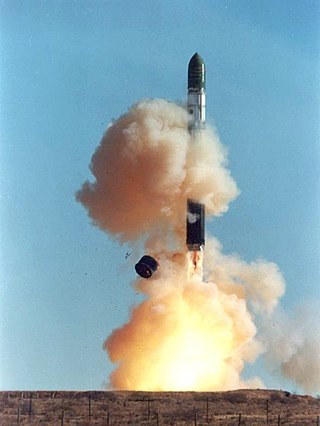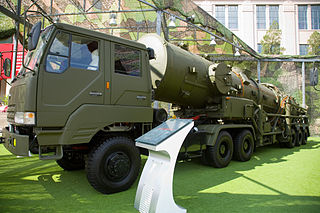
An intercontinental ballistic missile (ICBM) is a ballistic missile with a range greater than 5,500 kilometres (3,400 mi), primarily designed for nuclear weapons delivery. Conventional, chemical, and biological weapons can also be delivered with varying effectiveness, but have never been deployed on ICBMs. Most modern designs support multiple independently targetable reentry vehicle (MIRVs), allowing a single missile to carry several warheads, each of which can strike a different target. The United States, Russia, China, France, India, the United Kingdom, Israel, and North Korea are the only countries known to have operational ICBMs.

The Dongfeng series, typically abbreviated as "DF missiles", are a family of short, medium, intermediate-range and intercontinental ballistic missiles operated by the Chinese People's Liberation Army Rocket Force.

The People's Republic of China has developed and possesses weapons of mass destruction, including chemical and nuclear weapons. The first of China's nuclear weapons tests took place in 1964, and its first hydrogen bomb test occurred in 1967 at Lop Nur. Tests continued until 1996, when the country signed the Comprehensive Nuclear-Test-Ban Treaty (CTBT), but did not ratify it. China acceded to the Biological Weapons Convention (BWC) in 1984 and ratified the Chemical Weapons Convention (CWC) in 1997.

The R-36 is a family of intercontinental ballistic missiles (ICBMs) and space launch vehicles (Tsyklon) designed by the Soviet Union during the Cold War. The original R-36 was deployed under the GRAU index 8K67 and was given the NATO reporting name SS-9 Scarp. It was able to carry three warheads and was the first Soviet MRV missile. The later version, the R-36M, also known as RS20, was produced under the GRAU designations 15A14 and 15A18 and was given the NATO reporting name SS-18 Satan. This missile was viewed by certain United States analysts as giving the Soviet Union first strike advantage over the U.S., particularly because of its rapid silo-reload ability, very heavy throw weight and extremely large number of re-entry vehicles. Some versions of the R-36M were deployed with 10 warheads and up to 40 penetration aids and the missile's high throw-weight made it theoretically capable of carrying more warheads or penetration aids. Contemporary U.S. missiles, such as the Minuteman III, carried up to three warheads at most.

The Dongfeng 5 or DF-5 is a second-generation two stage Chinese intercontinental ballistic missile. It has a length of 38.5 m and a diameter of 4.08 m. It weighs in at 312,500 kilograms and it has an estimated range of 7,000 to 10,000 kilometers. The DF-5 had its first flight in 1971 and was in operational service 10 years later. One of the limitations of the missile is that it takes between 30 and 60 minutes to fuel. The DF-5 is due to be replaced by the solid-fuelled DF-41. Around 2015, the newest variant DF-5B force are believed to have received a MIRV upgrade; according to Business Insider, with DF-5B: "China has the ability to deliver nuclear warheads nearly anywhere on earth ".

The People's Liberation Army Rocket Force, formerly the Second Artillery Corps, is the strategic and tactical missile force of the People's Republic of China. The PLARF is the 4th branch of the People's Liberation Army (PLA) and controls China's arsenal of land-based ballistic, Hypersonic, cruise missiles—both nuclear and conventional. The armed service branch was established on 1 July 1966 and made its first public appearance on 1 October 1984. The headquarters for operations is located at Qinghe, Beijing. The PLARF is under the direct command of the Chinese Communist Party's Central Military Commission (CMC).

The Dong-Feng 15 is a short-range ballistic missile developed by the People's Republic of China. The DF-15 and the newer DF-16 are thought to be the only non-nuclear missiles in use by the People's Liberation Army Rocket Force. The U.S. Department of Defense estimated in 2008 that China had 315–355 DF-15 missiles and 90–110 launchers.

The Dong Feng 31 is a third-generation long-range, road-mobile, three stage, solid-fuel rocket intercontinental ballistic missile (ICBM) in the Dongfeng missile series developed by the People's Republic of China. It is designed to carry a single 1-megaton thermonuclear weapon. It is a land-based variant of the submarine-launched JL-2. It is operated by the Second Artillery Corps (SAC) which, in 2009, was estimated to have under 15 DF-31 missiles and under 15 DF-31A missiles in inventory. US Air Force National Air and Space Intelligence Center estimates that as of June 2017, five to ten Mod 1 and over fifteen Mod 2 launchers were operationally deployed.

The DF-3A is a Chinese liquid-fueled, single-stage, nuclear medium-range ballistic missile that entered service in 1971.

The Dong-Feng 21 (DF-21; NATO reporting name CSS-5 - Dong-Feng is a two-stage, solid-fuel rocket, single-warhead medium-range ballistic missile in the Dong Feng series developed by China Changfeng Mechanics and Electronics Technology Academy. Development started in the late 1960s and was completed around 1985–86, but it was not deployed until 1991. It was developed from the submarine-launched JL-1 missile, and is China's first solid-fuel land-based missile. The U.S. Department of Defense in 2008 estimated that China had 60-80 missiles and 60 launchers; approximately 10-11 missiles can be built annually.
Dongfeng is the romanization of several Chinese names of which most notably "East Wind". Dongfeng may refer to:

The Julang-1 was China's first generation nuclear submarine-launched ballistic missile (SLBM). According to a US Department of Defense report in 2011, the operational status of the JL-1 was "questionable".
The Dongfeng-41 or DF-41 is a fourth-generation Chinese solid-fuelled road-mobile intercontinental ballistic missile operated by the People's Liberation Army Rocket Force. DF-41 is the fourth and the latest generation of the Dongfeng series strategic missiles developed by China. The missile was officially unveiled at the China National Day military parade on 1 October 2019.

The Dong-Feng 11 is a short-range ballistic missile developed by the People's Republic of China.

The Dong Feng-26 or DF-26 is an intermediate-range ballistic missile deployed by the People's Liberation Army Rocket Force and produced by the China Aerospace Science and Technology Corporation (CASC).
The Underground Great Wall of China is the informal name for the 3,000 mile (5,000km) system of tunnels used by China to store and transport intercontinental ballistic missiles (ICBMs).

The 70th anniversary of the founding of the People's Republic of China was observed with a series of ceremonial events including a grand military parade as its spotlight to celebrate National Day of the People's Republic of China that took place on 1 October 2019 in Beijing. It was the largest military parade and mass pageant in Chinese history.

The Hanyang HY4260 is a model of military tractor trucks developed, produced and used by the People's Republic of China. These vehicles are primarily used to mount Beijing's ballistic missile family and are used in conjunction with other transporter erector launchers, to further bolster China's ballistic missile capabilities.

The Hanyang HY4330 is a large model of military tractor trucks developed and produced by the Hanyang Special Purpose Vehicle Institute, which in turn is used by the People's Republic of China. These trucks behave essentially like conventional transporter erector launchers and as such, are used primarily to offer Beijing second strike nuclear capabilities; bolstering China's ballistic missile capabilities.














